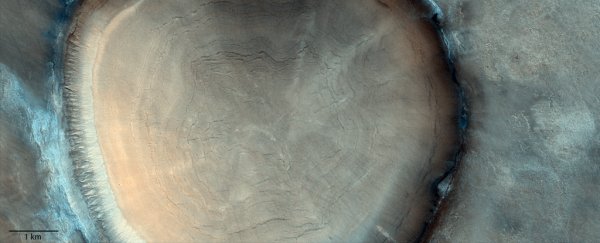You might be forgiven for thinking the above picture is the stump of a tree. Shift your perspective a little, however, and the truth becomes clear: What you're looking at is much bigger than any tree – a concave depression on the surface of Mars, gouged out by a massive impact.
The rings radiating out from the center of the crater are not tree rings – but just as tree rings can yield a glimpse into the history of a tree, so too can these crater rings help us to understand Mars.
The newly released image was taken during spring in Mars's northern hemisphere, on 13 June 2021, by the ESA/Roscosmos ExoMars Trace Gas Orbiter's CaSSIS instrument.
Even during the warmer months, however, Mars can be freezing cold; this crater in the Acidalia Planitia likely has frozen material year-round, and that material likely contains water ice.
We know this because of those rings. We know that water ice, because it is a strange substance, expands as it cools. As temperatures fluctuate on Mars, the material that is rich in water ice at the bottom of the pictured crater would likewise expand and contract.
It's this expansion and contraction, occurring repeatedly, that would create concentric fracture patterns across the crater floor, resulting in rings, and thus the illusion of a tree stump.
 (ESA/Roscosmos/CaSSIS)
(ESA/Roscosmos/CaSSIS)
This, in turn, can help planetary scientists to understand Mars's water history. At the position of the crater today, at 51.9 degrees latitude, it's too warm for water ice deposits to form.
However, while Mars has seasons due to an axial tilt, just like Earth does, it also has something in addition. The angle of Mars's axial tilt changes dramatically over long timescales – hundreds of thousands to millions of years.
This suggests that the deposits at the bottom of the crater were laid down at some point in the past, when the tilt of the Martian axis allowed for water ice deposits to form at lower latitudes than they do today.
Understanding the history of water on Mars is one of the most prominent goals of the study of the red planet. Not only will this yield insight into planet habitability, it will provide us with important information that will assist in planning future crewed and uncrewed missions to Mars.
You can download the above image in high resolution on the ESA website.
